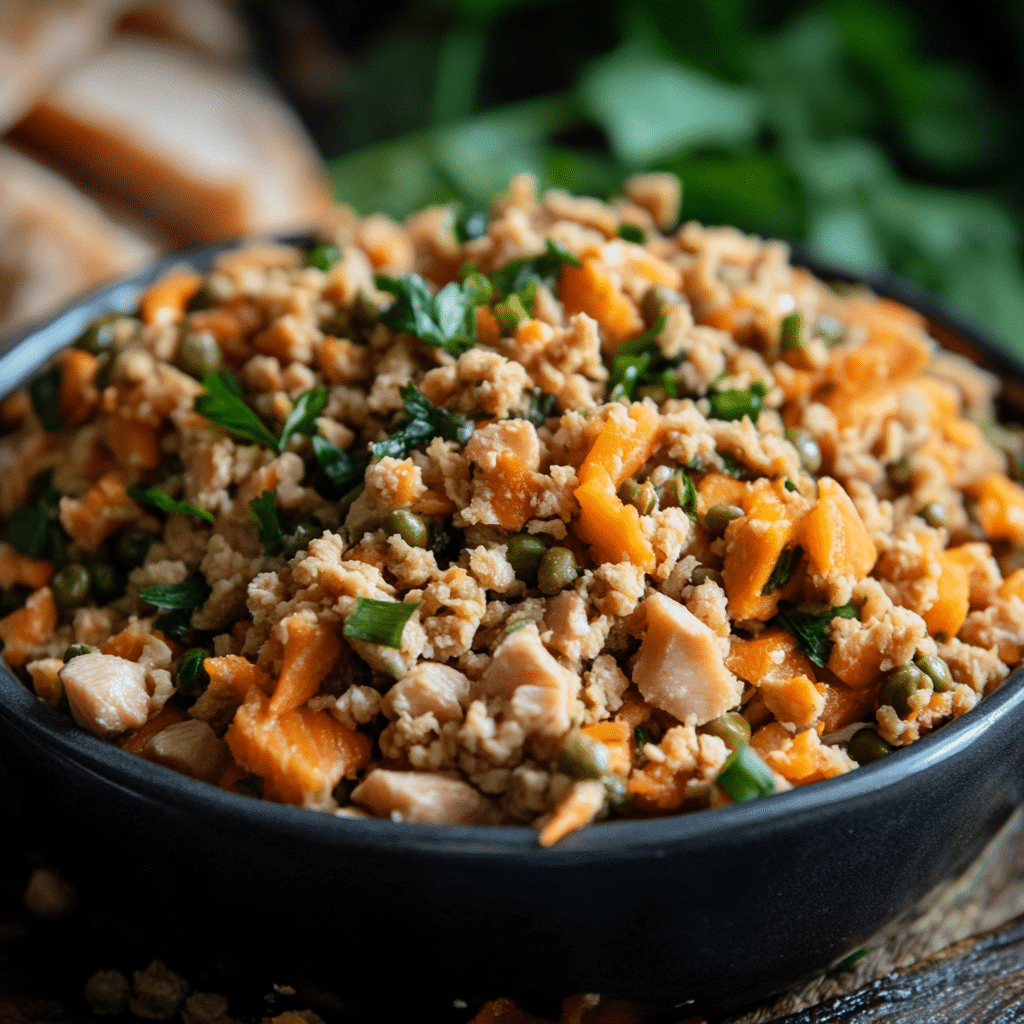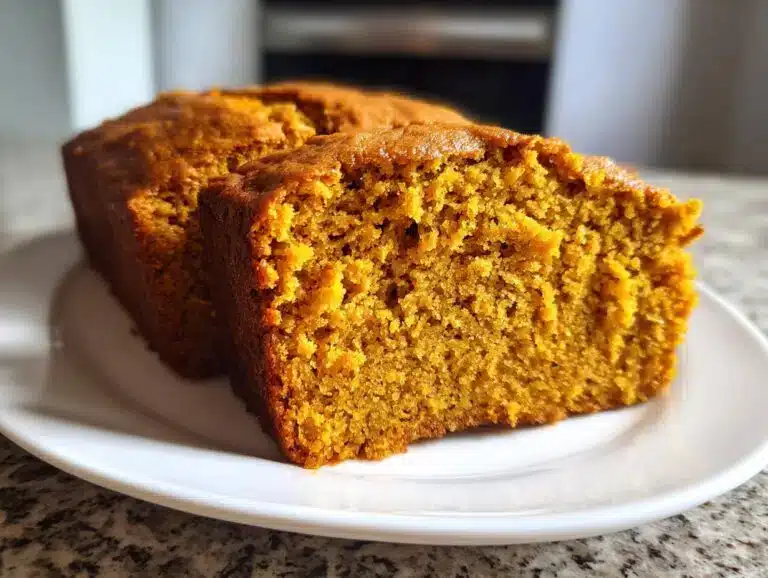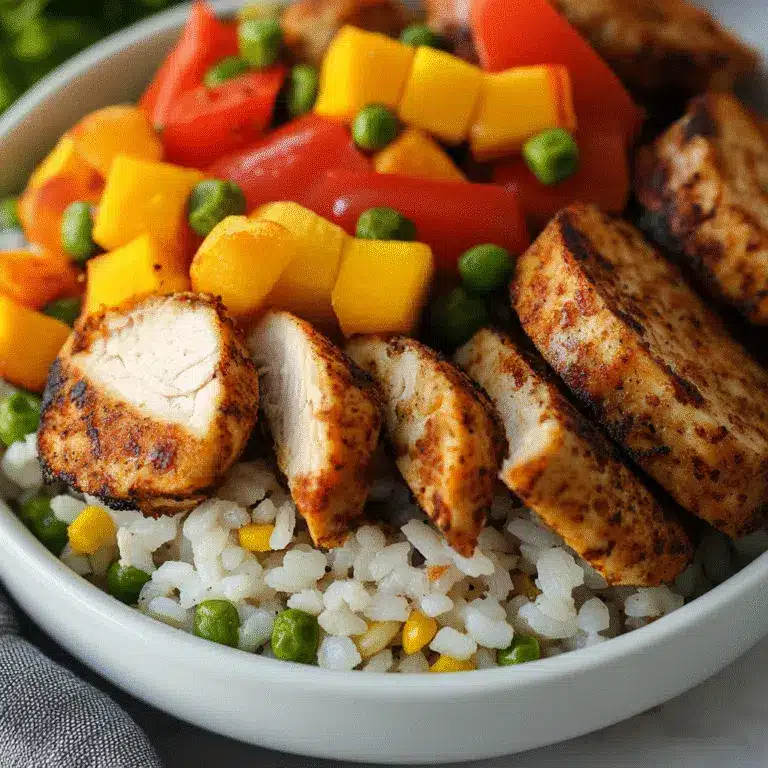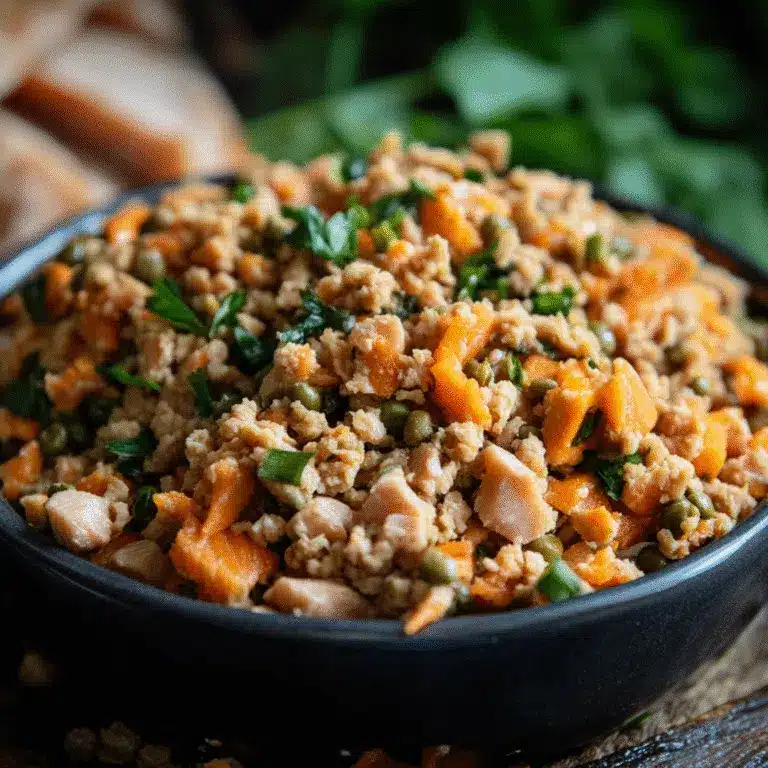Homemade dog food with canned salmon is a trending option among dog owners who want more control over their pet’s nutrition. It’s not only budget-friendly but also packed with essential nutrients like omega-3s and protein. Whether you’re dealing with picky eaters, food allergies, or just want to make a healthy switch, this guide will walk you through everything from safety concerns to recipes and feeding tips.
Check out how other pet lovers are improving their dog’s diet naturally in our post on homemade protein-packed meals for dogs.
Let’s start with understanding why homemade dog food with canned salmon is worth your attention.
1. Why Consider Homemade Dog Food With Canned Salmon?
The Benefits of Homemade Dog Food
Homemade meals give you total control over what goes into your dog’s bowl. Unlike commercial kibble, you avoid artificial preservatives, fillers, and mystery ingredients. You can tailor meals to your dog’s specific needs whether they require a low-fat diet, are allergic to certain proteins, or just need more whole foods.
Another huge perk? You know exactly how fresh the ingredients are. Homemade diets allow you to serve meals that are high in quality and taste. Plus, many dogs enjoy variety in flavor and texture, which is easier to provide when you prepare meals yourself.
Nutritional Profile of Canned Salmon for Dogs
Canned salmon is rich in omega-3 fatty acids, which support heart health, brain development, and shiny coats. It also provides lean protein for muscle repair and energy. Most canned salmon includes bones, which are a great source of calcium completely safe because the canning process softens them.
Below is a quick nutritional overview of one standard serving (100g) of canned pink salmon:
| Nutrient | Amount |
|---|---|
| Protein | 22g |
| Omega-3 Fatty Acids | 2.5g |
| Calcium (with bones) | 250mg |
| Calories | 136 kcal |
But not all canned salmon is created equal. Always choose a product that is unsalted and packed in water not oil or brine to keep sodium levels safe for dogs.
Learn more about protein variety in pet meals with our post on rotating animal-based proteins in dog diets.
2. Is Canned Salmon Safe for Dogs?
Understanding the Safety of Canned Salmon
When it comes to feeding your dog canned salmon, safety depends on a few key details. In general, canned salmon is safe for dogs as long as it’s plain, unsalted, and free from added oils or spices. Many dog owners are surprised to learn that the bones found in canned salmon are not only safe but also beneficial. Because they’re pressure-cooked during the canning process, they become soft and easy to digest.
However, some types of canned fish can contain added preservatives or seasonings like onion or garlic, which are toxic to dogs. Always read the label and avoid any product with added flavors.
Mercury is another concern, but salmon especially wild-caught has some of the lowest mercury levels of all seafood. As long as you’re not feeding your dog salmon every single day, mercury buildup isn’t a major risk.
Which Types of Canned Salmon Are Best?
When shopping, look for wild-caught canned salmon that is:
- Packed in water (not oil or brine)
- Free from added salt or seasoning
- BPA-free cans, if possible
- Labeled “boneless” if you’re concerned about small dogs or picky eaters
Here’s a quick comparison chart:
| Type of Canned Salmon | Safe for Dogs? | Notes |
|---|---|---|
| In water, no salt | Yes | Best option |
| In oil | No | Can cause digestive issues |
| With added salt | No | High sodium is unsafe |
| With bones | Yes | Bones are soft and digestible |
| Skinless, boneless | Yes | Great for small dogs |
Discover great ideas like choosing fish-based diets in our healthy dog food protein sources guide.
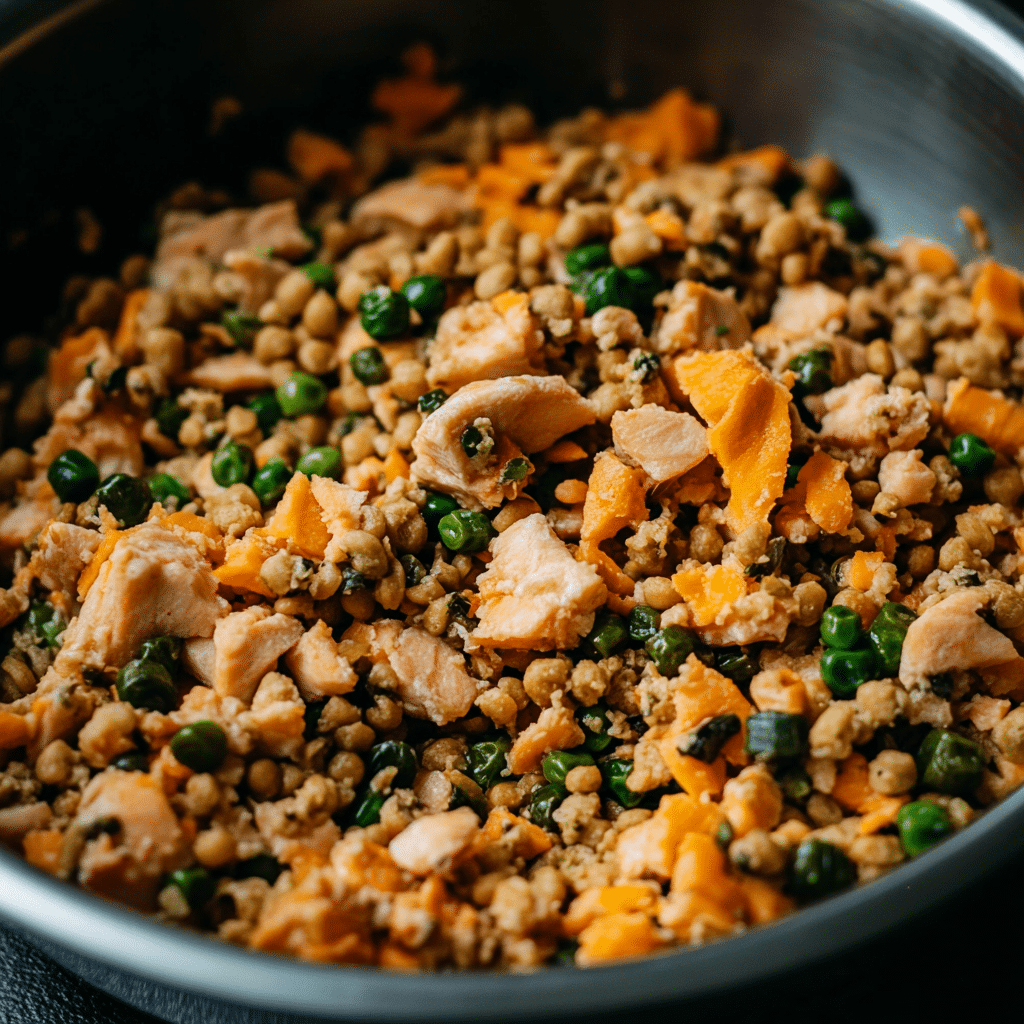
3. Health Benefits of Salmon in Homemade Dog Meals
Omega-3 Fatty Acids and Skin Health
One of the top reasons dog owners choose salmon is its high omega-3 fatty acid content. These healthy fats support a shiny coat, soothe itchy or dry skin, and reduce inflammation making them ideal for dogs with allergies or skin sensitivities. Omega-3s also support the immune system and help manage chronic conditions like arthritis or inflammatory bowel disease.
If your pup has a dull coat, constant shedding, or patches of dry skin, adding salmon into their diet can offer visible improvements within a few weeks. Plus, omega-3s are also known to reduce the risk of autoimmune issues and boost heart health.
How Salmon Supports Joint, Heart & Brain Health
Salmon is a rich source of essential nutrients beyond just protein. Here’s how it contributes to your dog’s overall wellness:
- Joint health: The anti-inflammatory properties in EPA and DHA (types of omega-3s) help ease stiffness in aging dogs or those with joint conditions.
- Heart health: Omega-3s can reduce triglycerides, support healthy blood pressure, and decrease the risk of heart disease.
- Brain development: In puppies, DHA is critical for cognitive function and brain development. In older dogs, it can improve memory and alertness.
Below is a breakdown of key salmon-based nutrients and their health benefits:
| Nutrient | Benefit |
|---|---|
| Omega-3s | Skin, joints, heart |
| Protein | Muscle growth and repair |
| Selenium | Immune system support |
| B12 | Brain function, energy |
| Niacin | Digestive health |
4. How to Prepare Homemade Dog Food With Canned Salmon
Choosing Safe Ingredients to Combine with Salmon
When preparing homemade dog food with canned salmon, balance is everything. While salmon provides excellent protein and healthy fats, your dog also needs carbohydrates, fiber, and vitamins from other food groups. Here are the safest and most nutritious ingredients to combine with salmon:
Vegetables
- Carrots (steamed or finely chopped)
- Green beans
- Spinach (in moderation)
- Zucchini
- Pumpkin (great for digestion)
Grains and Carbs
- White rice (easy to digest)
- Brown rice (adds fiber)
- Quinoa (high protein and gluten-free)
- Rolled oats (gentle on the stomach)
Fruits (in moderation)
- Blueberries (rich in antioxidants)
- Apple slices (no seeds)
- Banana (potassium boost)
Avoid these ingredients:
- Onions or garlic
- Grapes or raisins
- Salt, spices, and sauces
- Butter or cooking oils
Check out our list of vet-approved vegetables for homemade dog meals to create the perfect combo.
Step-by-Step Salmon Dog Food Recipe
Here’s a simple and safe recipe for homemade canned salmon dog food that your pup will love:
Ingredients
- 1 can of wild salmon in water (6 oz)
- 1 cup cooked white rice
- 1/2 cup cooked, mashed carrots
- 1/4 cup steamed green beans
- 1 tbsp pumpkin puree (unsweetened)
- Optional: 1/2 tsp ground flaxseed for fiber
- Optional: canine multivitamin (vet-approved)
Instructions
- Open the canned salmon and drain any excess liquid.
- Mix salmon (with bones and skin) into a large bowl.
- Add in the cooked rice, carrots, green beans, and pumpkin.
- Mix everything thoroughly until well combined.
- Portion into daily servings and store extras in the fridge for up to 3 days or freeze for longer.
Serving Tip: Serve the food slightly warm or at room temperature. Avoid serving cold from the fridge.
Discover great ideas like these in our roundup of easy meal-prep recipes for dogs using common pantry items.
5. Can You Feed Dogs Canned Salmon Every Day?
Safe Feeding Frequency Guidelines
While salmon is packed with health benefits, moderation is key. Feeding your dog canned salmon every single day isn’t usually recommended. Veterinarians typically advise limiting oily fish like salmon to 2–3 times per week, depending on your dog’s size, health, and diet variety.
Here’s a general guideline by dog size:
| Dog Size | Max Salmon Servings/Week | Portion Size |
|---|---|---|
| Small (5–20 lbs) | 1–2 meals | 1/4 – 1/3 cup cooked |
| Medium (20–50 lbs) | 2–3 meals | 1/2 – 1 cup cooked |
| Large (50+ lbs) | 3 meals | 1 – 1.5 cups cooked |
Overfeeding salmon can increase the risk of nutrient imbalances or mercury exposure over time. It’s also important not to rely on one protein source dogs, like humans, thrive on variety.
Don’t miss our article on portion control and meal rotation to build balanced, safe feeding schedules.
How to Rotate Proteins and Avoid Allergies
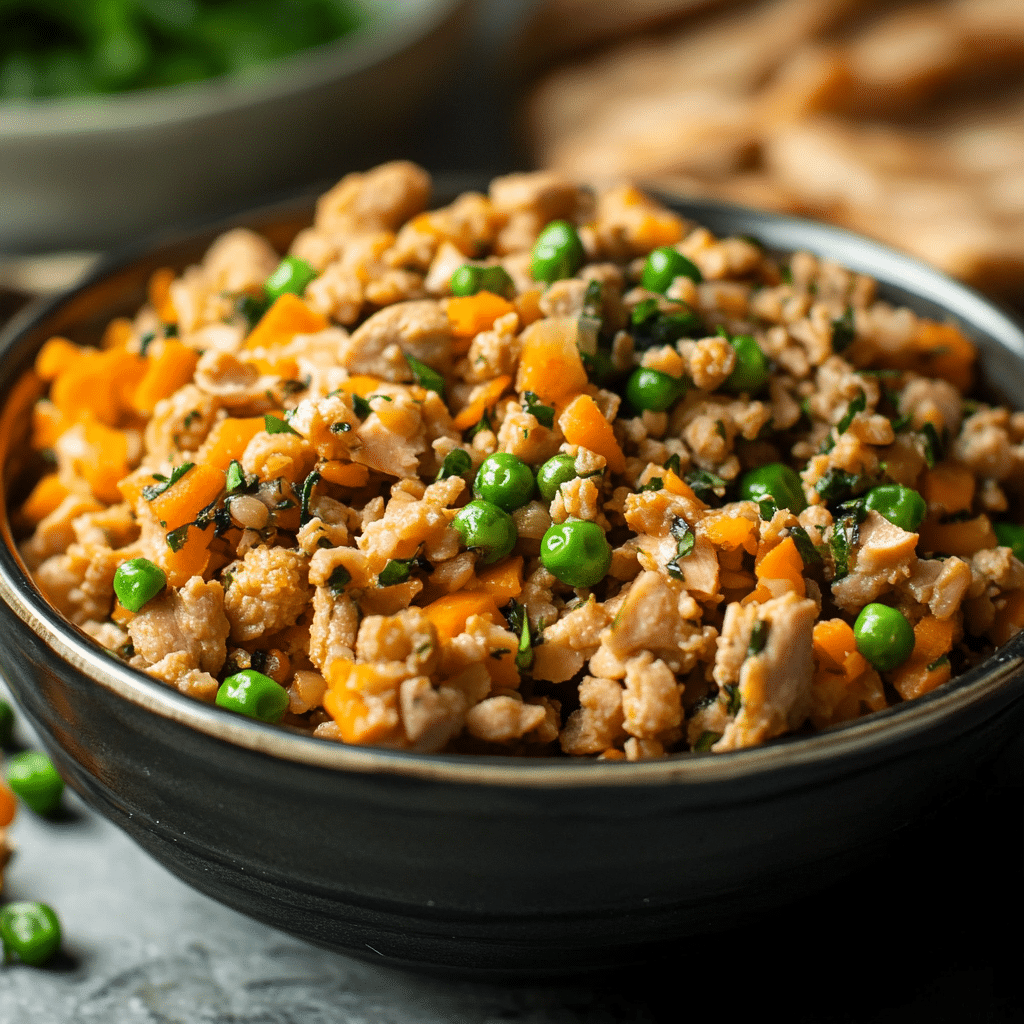
Rotating proteins helps prevent the development of food sensitivities and keeps your dog excited about their meals. Alongside salmon, try these safe protein sources:
- Chicken (boiled or baked, no seasoning)
- Turkey (lean and skinless)
- Beef (lean cuts)
- Lamb (less common but highly nutritious)
- Eggs (fully cooked, no salt)
If your dog has shown signs of food allergies itchy skin, excessive licking, ear infections, or digestive issues work with a vet to eliminate and reintroduce proteins safely.
Always observe how your dog reacts to each new ingredient. A healthy rotation schedule might include salmon 2–3 times a week, chicken another 2 days, and turkey or beef on alternate days.
Learn more about balancing proteins with our guide to hypoallergenic homemade dog food strategies.
6. Cost Comparison: Homemade vs Store-Bought Dog Food
What You Save With Homemade Salmon Meals
Homemade dog food with canned salmon can be surprisingly cost-effective especially when compared to high-quality, grain-free, or specialty dog food brands. While you’ll invest more time in meal prep, the savings over time can be significant.
Let’s compare:
| Food Type | Average Cost per Day (Medium Dog) | Notes |
|---|---|---|
| Premium Dry Dog Food | $2.50 – $4.00 | May contain fillers/preservatives |
| Fresh Subscription Meals | $4.00 – $7.00 | Convenient but expensive |
| Homemade Salmon Meals | $1.80 – $2.50 | Depends on local food prices |
With basic pantry items like rice, carrots, and canned salmon, you can feed your dog a balanced, nutrient-rich meal at a lower cost. And if you buy in bulk or prep meals for the week, you save even more on time and money.
Discover more ways to save in our guide to budget-friendly dog food planning.
Quality vs Cost: What’s Better for Your Dog?
Many commercial dog foods include cheap fillers like cornmeal, by-products, and artificial flavors. While some brands offer great nutrition, others cut corners for profit. Homemade meals give you the power to skip the junk and focus on whole, digestible ingredients that actually nourish your pet.
Plus, many owners report fewer vet visits, healthier coats, more energy, and better digestion after switching to home-cooked meals. Over time, this can reduce medical expenses and improve your dog’s quality of life.
If budget is a concern, start with just one or two homemade meals per week, then scale up as you learn what works best for your schedule and your dog’s health.
Looking for inspiration? Try our sample weekly dog meal plan that mixes homemade and commercial options for flexibility and balance.
7. Vet Tips and Warnings About Using Canned Salmon
Things Vets Want You to Know
Before switching your dog to a salmon-based homemade diet, it’s smart to check in with your veterinarian—especially if your dog has health issues or allergies. Vets often highlight the importance of balance. Feeding just salmon and rice, for example, can leave your dog lacking in certain vitamins and minerals over time.
Here are some common vet recommendations:
- Use canned salmon as a supplement, not the only protein source.
- Avoid seasoning or added fats, which can upset your dog’s digestive system.
- Check labels for hidden ingredients like sodium or preservatives.
- Add a canine multivitamin, especially if feeding homemade exclusively.
If your dog has kidney issues, pancreatitis, or a history of food sensitivities, professional guidance is essential before introducing salmon or any new protein.
Check out our dog nutrition checklist that vets use to assess homemade meal quality.
Warning Signs of Fish Allergies or Overfeeding
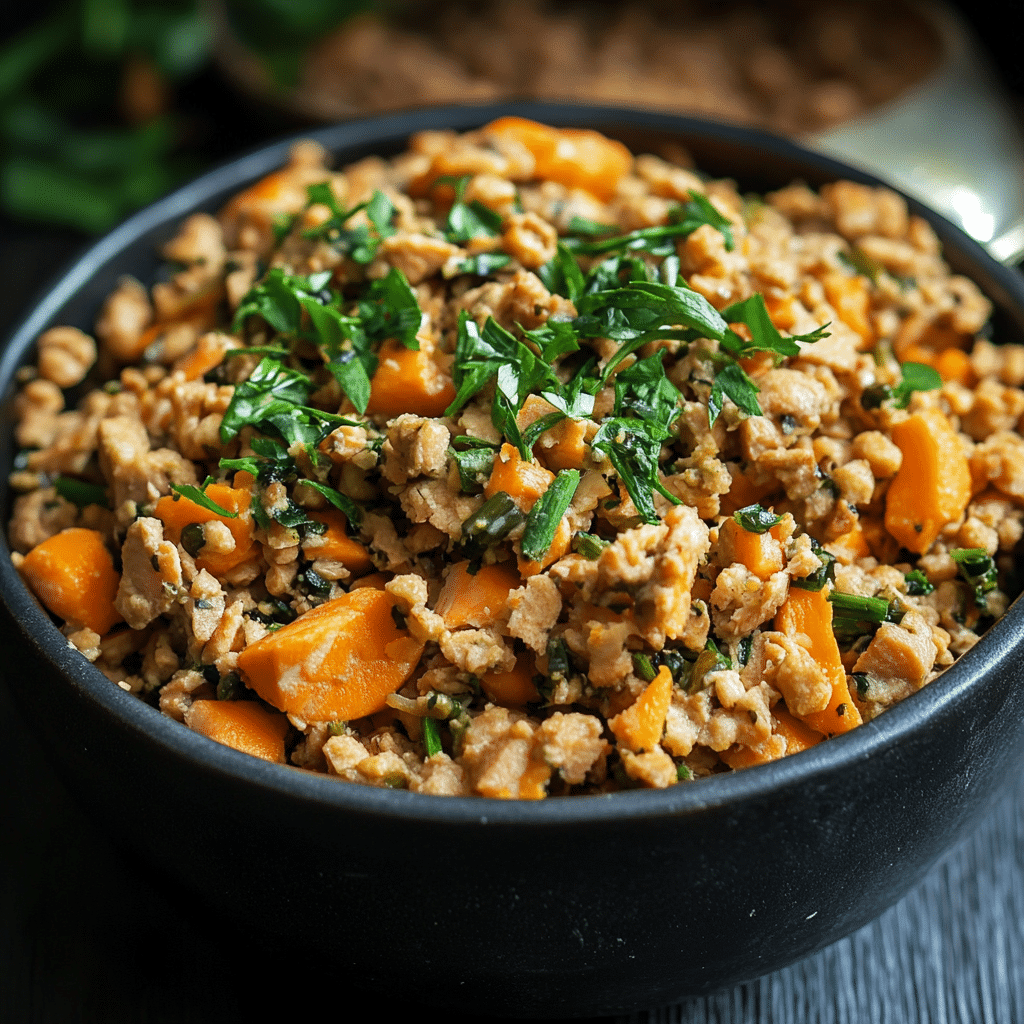
While most dogs tolerate salmon well, some may have sensitivities to fish or show signs of overfeeding. Watch for the following symptoms:
- Itchy skin or excessive licking
- Ear infections or head shaking
- Loose stools or diarrhea
- Gas or bloating
- Vomiting
If these signs appear, pause the salmon meals and consult a vet. It might not be the salmon itself but the way it’s prepared or mixed with other ingredients.
Keep in mind: fish allergies in dogs are rare, but they do happen. Rotating proteins, adding digestive enzymes, and starting with small portions can help prevent problems.
8. Best Vegetables and Add-Ins With Canned Salmon
Dog-Safe Vegetables That Go Well With Salmon
Adding vegetables to your dog’s homemade salmon meal not only boosts nutrition but also helps with digestion and adds bulk to keep them feeling full. The key is choosing ingredients that are safe and easy on their stomach.
Here are some top vegetables that pair well with canned salmon in dog food:
- Carrots: Rich in beta-carotene and fiber. Serve cooked or shredded raw.
- Green beans: Low-calorie, packed with vitamins A, C, and K. Steam for best results.
- Sweet potatoes: A great source of complex carbs and antioxidants. Cook thoroughly and mash.
- Zucchini: Hydrating and easy to digest. Slice thin or grate raw into meals.
- Pumpkin: Ideal for regulating digestion. Use plain canned pumpkin (not pie filling).
Below is a breakdown of dog-friendly veggies:
| Vegetable | Prep Method | Benefits |
|---|---|---|
| Carrots | Cooked/Raw | Eye health, fiber |
| Green Beans | Steamed | Weight control, vitamin C |
| Pumpkin | Mashed/Canned | Digestive support |
| Sweet Potatoes | Cooked/Mashed | Energy, gut health |
| Zucchini | Raw/Cooked | Hydration, low calorie |
Avoid starchy or gas-producing vegetables like peas, corn, onions, or broccoli. They may lead to discomfort or even toxicity in large amounts.
Learn more about veggie safety with our complete list of vegetables your dog can and can’t eat.
Optional Add-ins: Rice, Quinoa, Pumpkin, and More
Grains and carbs help round out a balanced meal. While some dogs do well on grain-free diets, many benefit from digestible carbohydrates when paired with protein-rich salmon.
Great carb and add-in options include:
- White rice: Easy to digest and a go-to for dogs with upset stomachs.
- Brown rice: Higher in fiber and minerals, but may be harder to digest for some dogs.
- Quinoa: A gluten-free pseudo-grain that adds protein and texture.
- Rolled oats: Great for sensitive stomachs and easy to prepare.
- Pumpkin: Excellent for fiber and digestive health.
- Chia or flax seeds: For added omega-3s and fiber. Use in small amounts.
9. Storage, Meal Prepping, and Serving Tips
Storing Homemade Dog Food Safely
Once you’ve prepared a fresh batch of homemade dog food with canned salmon, proper storage is essential to maintain freshness and prevent spoilage. Since there are no preservatives, homemade meals must be handled carefully.
Here’s how to do it right:
- Refrigerator: Store fresh portions in airtight containers for up to 3 days.
- Freezer: Freeze in single-meal portions using silicone molds or freezer-safe bags. Meals can last up to 2 months.
- Label and Date: Always mark containers with the prep date to avoid forgetting how long they’ve been stored.
Avoid storing food in metal containers and never leave meals at room temperature for more than an hour. Salmon-based meals can spoil quickly due to the natural oils.
Check out our kitchen guide to safe homemade pet food storage methods for every kind of ingredient.
How to Portion and Serve the Meals
Serving the right amount is crucial to avoid underfeeding or weight gain. The general guideline for home-cooked meals is about 2–3% of your dog’s ideal body weight per day, split into two meals.
Here’s a quick reference:
| Dog Weight | Daily Food Amount | Per Meal (Twice Daily) |
|---|---|---|
| 10 lbs | 1/4 – 1/2 lb | 1/8 – 1/4 lb |
| 30 lbs | 3/4 – 1 lb | 3/8 – 1/2 lb |
| 60 lbs | 1.5 – 2 lbs | 3/4 – 1 lb |
Serving tips:
- Always serve at room temperature or gently warmed (never hot).
- Mix dry supplements or multivitamins just before serving.
- Watch for leftovers dogs often leave behind veggies if not finely chopped or mashed.
FAQ
Can I use canned salmon to make dog food?
Yes, canned salmon is a safe and nutritious base for homemade dog food—when used correctly. Choose varieties packed in water with no added salt or seasonings. The bones in canned salmon are soft and edible, offering added calcium.
Is canned salmon safe for my dog?
Canned salmon is generally safe for dogs when served in moderation. Avoid options with added sodium, oils, or spices. Wild-caught salmon is best, as it contains fewer contaminants like mercury.
Is salmon good for homemade dog food?
Absolutely. Salmon is an excellent protein source rich in omega-3 fatty acids, B vitamins, and selenium. It supports coat health, joint function, and immune strength—making it a premium ingredient in homemade dog meals.
How to prepare salmon for dog food?
Use canned salmon packed in water, then drain and mix it with cooked vegetables and dog-safe grains like rice or quinoa. Avoid spices or oils. You can serve it warm or room temperature. For variety, blend in pureed pumpkin or sweet potatoes.
Can I feed my dog salmon every day?
Feeding salmon every day is not recommended due to potential nutrient imbalance and mercury accumulation. Most vets suggest offering salmon 2–3 times per week alongside other proteins like chicken, turkey, or beef.
For more recipes follow me on PINTEREST
PrintHomemade Dog Food With Canned Salmon: Safe, Nutritious & Easy Guide
A wholesome, protein-rich homemade dog food recipe made with canned salmon, rice, vegetables, and pumpkin. Balanced, budget-friendly, and full of omega-3s—perfect for improving your dog’s skin, joints, and digestion. Easy to prep, dog-approved, and great for meal planning.
- Prep Time: 15 minutes
- Cook Time: 20 minutes
- Total Time: 35 minutes
- Yield: 1 meal for medium dog (30–50 lbs) 1x
- Category: Dog Food Recipes
- Method: Mixing, Meal Prep
- Cuisine: American Homemade
Ingredients
-
1 can wild-caught salmon in water (6 oz)
-
1 cup cooked white or brown rice
-
1/2 cup cooked and mashed carrots
-
1/4 cup steamed green beans
-
1 tablespoon unsweetened pumpkin puree
-
Optional: 1/2 teaspoon ground flaxseed
-
Optional: vet-approved multivitamin supplement
Instructions
-
Drain the canned salmon (leave soft bones for added calcium).
-
Cook the rice and vegetables until soft, then let them cool.
-
Combine all ingredients in a large mixing bowl.
-
Stir until evenly mixed into a consistent, moist blend.
-
Serve at room temperature.
-
Store leftovers in airtight containers in the fridge for up to 3 days or freeze for up to 2 months.
Nutrition
- Serving Size: 1 meal for medium dog (30–50 lbs)
- Calories: 320–350 kcal
- Sodium: Low (unsalted salmon)
- Fat: 12–14 g
- Carbohydrates: 20–22 g
- Fiber: 3 g
- Protein: 24–26 g

